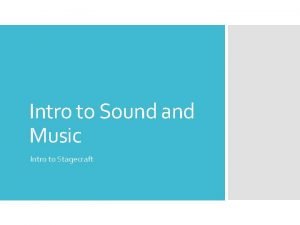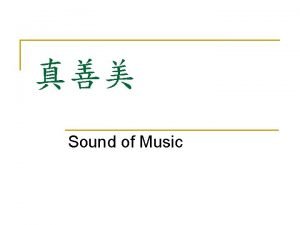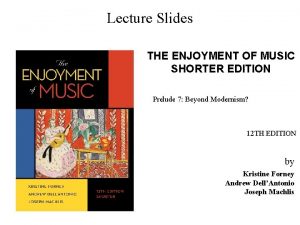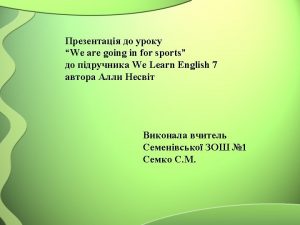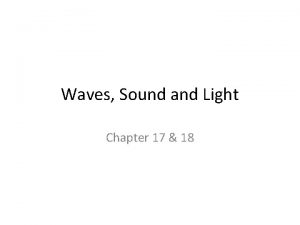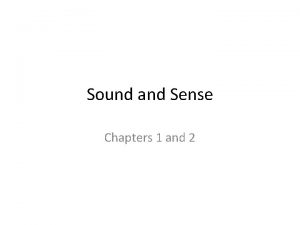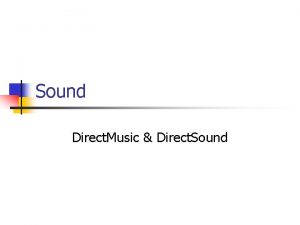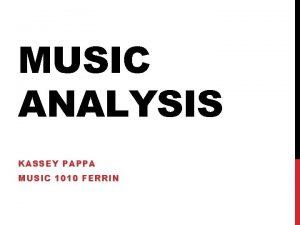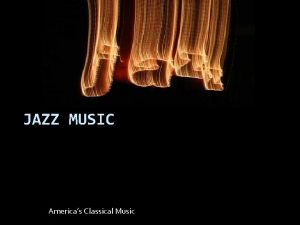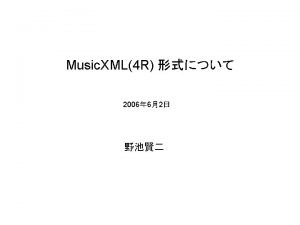SOUND and MUSIC Chapter 15 Sound sound is














- Slides: 14

SOUND and MUSIC Chapter 15

Sound sound is a longitudinal wave - air molecules vibrate along the direction the wave is travelling - vibration of molecules causes compressions and rarefactions that travel through the air n As with all waves, it is energy (and not mass) that is transported along the path n sound moves with a finite speed Vs=u=343 m/s (1125 feet per second) (in air at room temperature) n u depends on temperature, density, material properties, aggregation state n speed of sound bigger in solids, n or gases with smaller atomic mass

Hearing Sounds n n Sound perception is a complex phenomenon science fields involved in understanding it: physiology, psychology, acoustics acoustic--> the field of physics dealing with sound perception different in many aspects from the objective physical characteristic of sound We distinguish: -loudness -sound “color” and frequency Our sense of loudness is not linear in intensity and depends on the frequency! The range of frequency we hear: 20 - 20 000 Hertz (1/s) most sensitive: 3000 Hertz

Distinguishing Sounds n n We have usually no trouble identifying most of the sounds we hear What makes sounds so characteristic? - different notes ? ? ? - different loudness ? ? ? Answer: the “coloring” - we usually hear a superposition of different frequencies - the fundamental frequency is accompanied by higher harmonics with different weights is the total intensity - the manner in which the various components of the sound decay also differs from one instrument to another methods of detecting the harmonics, and their weights: - oscilloscopes; Fourier transforms

Measuring Sound Intensity Physical measure: energy delivered to a unit surface in unit time: Watts/m 2 n Our perception of loudness is not proportional with the physical measure (increasing 8 times the energy we hear it only 2 times louder) n Our ear has a very wide range of sensitivity: - the faintest sounds that can be heard 10 -12 W/m 2 (variations of pressure of about one billionths of an atmosphere) - pain sensation : 1 W/m 2 n A logarithmic scale for characterizing our loudness perception: decibels (d. B) (reflects the loudness sensation) - an increase of 10 times in the power, increases this measure by adding 10. - the hearing threshold : 1 d. B - pain: 120 d. B n

Musical instruments All instruments involve the production of standing waves n Grouped as a function of the origin of the sound: I. String Instruments (oscillations produced by the vibration of a cord) II. Wind Instruments (oscillations produced by the vibration of air columns) III. Percussion Instruments (vibration of membranes, or other solid objects) n

Stringed Instruments n n n based on vibration of a strings: violin, cello, piano, guitars, harp…… amplified by a larger body: resonator (the box on which the strings are attached) fundamental frequency (standing wave) is accompanied by the harmonics - fundamental wavelength: 2 l; harmonics wavelength: l, 2/3 l, l/2, . . Fundamental frequency varied by the: - length of the string (a collection of different lengths, or modifying the length by pressing…. ) - tension in the spring

Wind Instruments Containers for vibrating columns of air: clarinets, trumpets, organ pipes, …. --> an open end to transmit the sound+ a method for exciting the air column n in many ways analogous to the stringed instruments - standing waves are generated - the fundamental mode is accompanied by the harmonics n differences from the stringed instruments: - speed of waves cannot be changed (frequency tuned only by the length of the vibrating air column) - a node at one end, and antinode at the open end - origin of sound -->longitudinal standing wave n Fundamental wavelength: 4 l Harmonics wavelength: 4/3 l; 4/5 l; 4/7 l; …. .

Percussion Instruments n n n Membranes or solids that can vibrate very wide range: drums, cymbals, bells, gongs, xylophones, triangles…. lack of a well-defined harmonic structure (resonate at a variety of frequencies, the higher frequency are not wholenumber multiples of the lower one!) each instrument behave in a different way complex 2 D or 3 D structure of nodal and antinodal lines

Beats n Two steady sounds with nearly equal frequencies produces a periodic variation in the volume--> beats n As the two frequencies are closer and closer the period of the beats increases For two completely different frequencies the period of beats is so small, that we cannot observe it The beat frequency is the difference of the two sound frequency Piano and instrument tuners use this phenomenon n

Doppler Effect n n If we listen to the sound produced by a moving object (or we move relative to the sound source) we not necessarily observe the sound that was originally produced Example: car passes nearby you -the volume changes (increases after which decreases) -the frequency changes (higher after which lower) Shift of frequency due to motion --> Doppler effect Key to understanding it: - frequency with which crests hit our ears --> pitch of the sound (ears sensitive to the frequency!) - if the source and ear are stationary relative to each other, the frequency heard is the one emitted - if the source is moving the listener hears another frequency: waves crowd together in the forward direction and spread out in the backward direction (we observe higher frequency while the object moves toward us, and lower when departs) n Doppler effect also occurs when the receiver moves

Shock Waves Shock waves occur when a wave source moves faster than the speed of the wave in the medium n the expanding waves superimpose and form a conical pattern n The amplitude along the edge of the cone becomes very large (the waves add together with their crest lined up) n the edge of the cone--> shock wave n Examples: - supersonic planes - boats on water n

Summary n n n n Sound is a longitudinal wave that travels through many media The speed of sound in air is: 343 m/s (at room temperature) speed of sound depends on the media it travels: material, pressure, temperature, aggregation state …… ears detect sound waves and send electric signals to the brain the audible range for human: 20 -20, 000 Hz sound sources are special due to their “coloring” (content of harmonics) musical instruments involve the production of standing waves - three main types of instruments: string, wind and percussion instruments - for string and wing instruments the frequency of the harmonics is an integer multiple of the fundamental one - different notes are generated by changing the standing wave condition n n Two steady sounds with nearly equal frequencies superimpose to form beats: periodic variation of the loudness of sound The frequency of the sound from a moving object is shifted in frequency according to the Doppler effect. - The shift in the frequency is constant as long as the velocity is. - Doppler effect occurs for all kinds of waves. n When a source of waves moves faster than the speed of the waves--> shock wave is formed (edge of the shock-wave cone high amplitude)

Home-work assignments n n I. Part 384/3 -12, 14, 16 -18, 22 385/23 -25, 27, 3032, 34, 36, 38 -40 386/1 -2 387/3, 5, 8 -12 II. Part 385/41 -42 386/43 -45, 47 -52, 54, 55, 57, 58 387/13 -16, 18 -19, 21 -22, 24 -26
 Music music music
Music music music Very romantic music
Very romantic music 8 elements of music
8 elements of music What music that employs electronic music?
What music that employs electronic music? Musical form of pamulinawen
Musical form of pamulinawen Sound of music intro
Sound of music intro Lonely goatherd youtube
Lonely goatherd youtube Music is organized sound
Music is organized sound Ehat is sound
Ehat is sound Chapter 10. western musical instruments
Chapter 10. western musical instruments Chapter 68 underscoring meaning
Chapter 68 underscoring meaning “a sound mind is in a sound body”
“a sound mind is in a sound body” Two vocal style of singing in pakistan
Two vocal style of singing in pakistan Different types of mechanical waves
Different types of mechanical waves Sound and sense chapter 1 answers
Sound and sense chapter 1 answers





